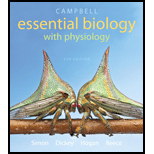
An atom can be changed into an ion by adding or removing _____. An atom can be changed into a different isotope by adding or removing________.
To determine: The sub-atomic particles whose addition or subtraction can give rise to an ion and an isotope.
Introduction:
The atom is the smallest unit of biological organization. However, there are particles even smaller than an atom and that together make up the atom. These sub-atomic particles include protons, neutrons, and electrons. In the center of an atom, the nucleus is present, which is composed of protons (positively charged particles) and neutrons (neutral particles). Electrons (negatively charged particles) revolve around the nucleus in designated orbitals.
Answer to Problem 1SQ
Correct answer: An atom can be changed into an ion by adding or removing electrons. An atom can be changed into a different isotope by adding or removing neutrons.
Explanation of Solution
An ion is a charged particle formed by the atoms to attain stability. Atoms can either form a positively charged ion called a cation or a negatively charged ion called an anion. Ions are formed by the change in the number of electrons. If electrons are lost, the positive charge on the atom increases and it forms a cation. If electrons are gained by the atom, the atom gets negatively charged and forms an anion. For example, the sodium (
Isotopes are variants of the same element but with different mass. The mass of an atom is composed of the masses of protons and neutrons in the nucleus. If the number of protons is changed, the element will change. Thus, for the formation of an isotope, the number of neutrons is supposed to change. For example, the isotopes of hydrogen (zero neutrons) include protium (zero neutrons), deuterium (one neutron) and tritium (two neutrons).
To form an ion, the number of electrons is supposed to be changed and to form an isotope, the number of neutrons is supposed to change.
Want to see more full solutions like this?
Chapter 2 Solutions
Campbell Essential Biology with Physiology (5th Edition)
Additional Science Textbook Solutions
HUMAN ANATOMY
Genetics: From Genes to Genomes
Campbell Essential Biology (7th Edition)
Physical Science
Laboratory Manual For Human Anatomy & Physiology
- State the five functions of Globular Proteins, and give an example of a protein for each function.arrow_forwardDiagram of check cell under low power and high powerarrow_forwarda couple in which the father has the a blood type and the mother has the o blood type produce an offspring with the o blood type, how does this happen? how could two functionally O parents produce an offspring that has the a blood type?arrow_forward
- What is the opening indicated by the pointer? (leaf x.s.) stomate guard cell lenticel intercellular space none of thesearrow_forwardIdentify the indicated tissue? (stem x.s.) parenchyma collenchyma sclerenchyma ○ xylem ○ phloem none of thesearrow_forwardWhere did this structure originate from? (Salix branch root) epidermis cortex endodermis pericycle vascular cylinderarrow_forward
- Identify the indicated tissue. (Tilia stem x.s.) parenchyma collenchyma sclerenchyma xylem phloem none of thesearrow_forwardIdentify the indicated structure. (Cucurbita stem l.s.) pit lenticel stomate tendril none of thesearrow_forwardIdentify the specific cell? (Zebrina leaf peel) vessel element sieve element companion cell tracheid guard cell subsidiary cell none of thesearrow_forward
- What type of cells flank the opening on either side? (leaf x.s.) vessel elements sieve elements companion cells tracheids guard cells none of thesearrow_forwardWhat specific cell is indicated. (Cucurbita stem I.s.) vessel element sieve element O companion cell tracheid guard cell none of thesearrow_forwardWhat specific cell is indicated? (Aristolochia stem x.s.) vessel element sieve element ○ companion cell O O O O O tracheid O guard cell none of thesearrow_forward
 Concepts of BiologyBiologyISBN:9781938168116Author:Samantha Fowler, Rebecca Roush, James WisePublisher:OpenStax College
Concepts of BiologyBiologyISBN:9781938168116Author:Samantha Fowler, Rebecca Roush, James WisePublisher:OpenStax College
 Biology Today and Tomorrow without Physiology (Mi...BiologyISBN:9781305117396Author:Cecie Starr, Christine Evers, Lisa StarrPublisher:Cengage Learning
Biology Today and Tomorrow without Physiology (Mi...BiologyISBN:9781305117396Author:Cecie Starr, Christine Evers, Lisa StarrPublisher:Cengage Learning Biology 2eBiologyISBN:9781947172517Author:Matthew Douglas, Jung Choi, Mary Ann ClarkPublisher:OpenStax
Biology 2eBiologyISBN:9781947172517Author:Matthew Douglas, Jung Choi, Mary Ann ClarkPublisher:OpenStax





